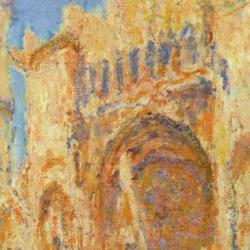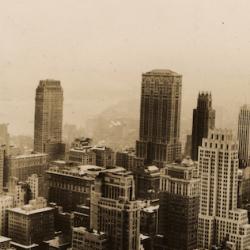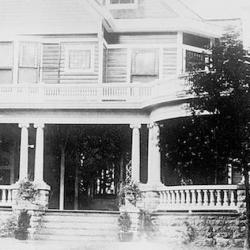America has a unique architecture, indebted to our unique religious makeup. In a 1982 article, Thomas Beeby notes that the communal experiments of early Puritans, and later of Quakers, Shakers, Moravians, and Pietists provided “paradigms of puritanical Protestant architectural thought” (essay reprinted in The Religious Imagination in Modern and Contemporary Architecture, 13).
With no “pre-existent Catholic society” or architecture to reckon with, American architecture could respond to its own religious impulses and its own setting in the new world: “Wilderness was not a biblical metaphor but a threatening reality awaiting Edenic transformation. As cultural traditions grew from religious roots, Protestant groups spread west in pursuit of the Wilderness, the true home of asceticism. A unique architectural language, common only to this continent, resulted and, as with the parallel literary tradition, became part of the unconscious sensibility of all Americans” (13).
Beeby provides a more elaborate description of the standard American architectural plan. He speaks of architectural asceticism and a drive toward purity and plainness: “Early framed houses in New England display similar formal characteristics as do vernacular buildings throughout middle-America. The dominance of the construction method, over all other architectural considerations, produces a severity of expression that fulfills the puritanical drive against superfluity. . . . A core contains all elements not easily placed within space surrounding it. Service spaces and chimneys become a dense mass rising through the heavy timber framing members The central mass replaces the central void of inwardness found in Catholicism. . . . The abstract purity of the central core plan suggests a desire . . . to produce a building type of such simplicity as to create a moral exemplar, as a reminder to the occupants of their place in the world” (20). In these buildings “ornamentation is kept to an absolute minimum and centered on crafted elements rather than decorative schemes” (20).
Beeby argues that what he calls “radical Protestant” or even “Anabaptist” aesthetic coincides with the aesthetic of high modernist architecture. This is missed because modernism is defined “in European psychological, political and social dialectic rather than in American moral imperatives,” but there is “an unbroken continuity of concern emanating from the ascetic tradition of this country” (13-14).
He finds a bridge between “puritan” architecture and Modernism in the work of Rudolf Schwarz, whose 1938 book, The Church Incarnate, was published in English in 1958, with a foreword by Mies van der Rohe. Mies claimed that he had read the book “over and over” and that it gave “real insight.”
Schwarz contrasts the “sacred inwardness” of the “ring” design in ancient and in medieval architecture with post-Reformation architecture. In the older forms of architecture, the building was a “genuine world-image,” an icon of the world. And there was continuity between the ancient pagan cosmomorphic architecture and Catholic architecture, centered on the Eucharist. With the table at the center, “the people are bound hand in hand into the ring but they are not completely absorbed by it. . . . Standing in the ring, the people mark off, secure a bit of land as the secure earth of home: a city is founded and fortified by an encircling wall” (quoted, 15). Even on larger scales, Catholic churches maintain this ring construction. For Schwarz (in Beeby’s words), “the Basilica of St. Peter is essentially an expanded version of this church” (15).
With Protestantism, the model moves from a sacred ring to a sacred way. On this plan, church architecture depicts a “parting, setting forth”: “The plan raises to lasting condition the moment in which the closed form parts, bursts open. The people are at the point of going out into the openness, they wish to take the first step but they tarry a moment, on the threshold between security and the way. The sheltering forms are still at hand but now have broken open and are beginning to disappear – they are no longer valid. The way is already at hand but at this moment the people have not yet entered upon it and hence it is still impossible. Breached are the original forms” (quoted, 16). Instead of circling a table and looking at each other, the people are lined in columns, all facing the same direction, shoulder to shoulder rather than face-to-face. Schwarz points out that Eucharistic theology and practice are again central: The supper is a commemoration, and so even at the table, the people are looking outward toward heaven or the second coming rather than inward toward one another or to the host that represents the people.
This “way-form” provides “the spiritual basis of Mies’ work in America,” especially on the campus of the Illinois Institute of Technology: “The Illinois Institute of Technology lies within the insistent grid of Chicago that runs from the Prarie to the Lake, where it dies with no compromise, never producing a center. Mies further subdivided this street grid down to a six foot modular network that he placed over the entire site. Then, rather than embracing the nineteenth-century street facades, Mies turned his back on the surroundings by rotating the perimeter buildings perpendicularly to the surrounding facades or setting them back from the edges. This approach is similar to the planning of Shaker communities or the Amana colonies and is consistent with Anabaptist thought” (18).















